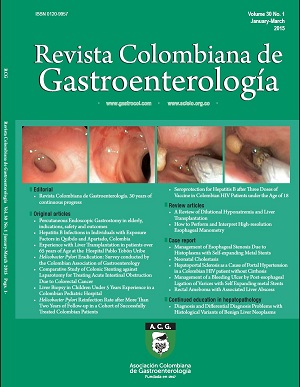Report of 21 Cases of Neonatal Cholestasis in a Children’s Hospital in Cartagena, Colombia
DOI:
https://doi.org/10.22516/25007440.27Keywords:
Neonatal cholestasis, bilirubin, biliary atresia, neonatal jaundice, neonatal sepsisAbstract
Cholestasis is an alteration in the flow of bile resulting from decreases or cessation of biliary excretion. To date, there have been only a few studies on this topic in Colombia. This article presents twenty-one cases of neonatal cholestasis from a Children’s Hospital in Cartagena, Colombia that occurred between 2010 and 2013. The aim of this study is to characterize the etiology and clinical characteristics of the disease. Patients between birth and 3 months old with direct bilirubin levels over 2 mg/dl were selected. By gender, 52.4% of the patients were male, and 47.6% were female. 76.2% of the patients were full term, and 57.1% had no perinatal antecedents. Clinical symptoms presented in the first 30 days after birth in 71% of the patients, and 4 patients were referred for liver transplantation. The most common etiology was infectious (13 patients), and 4 patients had atresia. The most common cause of neonatal cholestasis in this study was infection, but obstructive
disorders such as biliary atresia still account for an important proportion of the patients. They require priority study and handling because early intervention results in better prognoses.
Downloads
References
Frauca E, Muñoz G. Conestasis en el lactante. En: Protocolos de gastroenterología, hepatología y nutrición (AEP). 2.a edi- ción. España: Ergón S.A. ed; 2010. p. 177-87.
Samyn M, Mieli-Vergani G. Liver and biliary disease in infancy. Medicine 2007;35(2):61-6.
Bellomo-Brandao MA, Porta G, Hessel G. Clinical and labo- ratory evaluation of 101 patients with intrahepatic neonatal cholestasis. Arq Gastroenterol 2008;45(2):152-5.
Heller S. Colestasis neonatal. MedUNAB 2005;8(1):S18- 25.
Wagner M, Zollner G, Trauner M. New molecular insights into the mechanisms of cholestasis. J Hepatol 2009;51(3):565-80.
Trauner M, Meier PJ, Boyer JL. Molecular pathogenesis of cholestasis. N Engl J Med. 1998 Oct 22;339(17):1217-27.
McKiernan PJ. Neonatal cholestasis. Semin Neonatol 2002;7(2):153-65.
De Bruyne R, Van Biervliet S, Vande Velde S, Van Winckel M. Clinical practice: neonatal cholestasis. Eur J Pediatr 2011;170(3):279-84.
Hondal Alvarez N, Silverio García C. Comportamiento de la colestasis del recién nacido y del lactante en el Hospital Pediátrico “William Soler”. Rev Cub Pediatr 2010;82:13-9.
Ciocca M, Alvarez F. Transient neonatal cholestasis. Arch Argent Pediatr 2011;109(2):163-6.
Lorente S, Montoro MA. Cholestasis of pregnancy. Gastroenterol Hepatol 2007;30(9):541-7.
Girard M, Lacaille F. Diagnosis of neonatal cholestasis. Annales Nestlé (English ed). 2008;66(3):109-20.
López Panqueva R. Aproximación al diagnóstico patológico de las enfermedades colestásicas. Rev Col Gastroenterol 2014;29:189-99.
Balistreri WF. Neonatal cholestasis: lessons from the past, issues for the
future. Semin Liver Dis 1987;7(2):61-6.
Fischler B, Papadogiannakis N, Nemeth A. Aetiological fac- tors in neonatal cholestasis. Acta Paediatr 2001;90(1):88-92.
Venigalla S, Gourley GR. Neonatal cholestasis. Semin
Perinatol 2004;28(5):348-55.
Balistreri WF. Neonatal cholestasis. J Pediatr 1985;106(2):171-84.
Donat Aliaga E, Polo Miquel B, Ribes-Koninckx C. Atresia
de vías biliares. An Pediatr (Barc) 2003;79(02):168-73.
Balistreri WF, Heubi JE, Suchy FJ. Immaturity of the ente- rohepatic circulation in early life: factors predisposing to “physiologic” maldigestion and cholestasis. J Pediatr Gastroenterol Nutr 1983;2(2):346-54.
Hierro L, Jara P. Childhood cholestasis and bile transpor-
ters. Gastroenterol Hepatol 2005;28(7):388-95.
López-Manzanares J, Medina Benítez E. Colestasis en el recién nacido y lactante. Orientación diagnóstica. An Pediatr 2003;58(02):162-7.
Moyer V, Freese DK, Whitington PF, Olson AD, Brewer
F, Colletti RB, et al. Guideline for the evaluation of cho- lestatic jaundice in infants: recommendations of the North American Society for Pediatric Gastroenterology, Hepatology and Nutrition. J Pediatr Gastroenterol Nutr
;39(2):115-28.
Suchy FJ. Neonatal cholestasis. Pediatr Rev 2004;25(11):388-96.
Jacquemin E, Lykavieris P, Chaoui N, Hadchouel M, Bernard
O. Transient neonatal cholestasis: origin and outcome. J Pediatr 1998;133(4):563-7.
Méndez V, Burastero M, Cuadro MN, Casamayou L,
GutiéRrez C, Montano A, et al. Colestasis neonatal: evo- lución de los pacientes diagnosticados entre 1983 y 2000 en dos servicios gastroenterológicos de referencia de Montevideo. Arch Pediat Urug 2005;76:210-21.
Mowat AP, Davidson LL, Dick MC. Earlier identification of biliary atresia and hepatobiliary disease: selective screening in the third week of life. Arch Dis Child 1995;72(1):90-2.
Roberts EA. Neonatal hepatitis syndrome. Semin Neonatol 2003;8(5):357-74.
Vidal Duran C, Ureche Aguarán G. Hepatitis A colestásica. A propósito de un caso. Rev Col Gastroenterol 2006;21:225-9.
Glassman MS, Dellalzedah S, Beneck D, Seashore JH. Coincidence of congenital toxoplasmosis and biliary atresia in an infant. J Pediatr Gastroenterol Nutr 1991;13(3):298-300.
Robino L, Machado K, Montano A. Neonatal cholestasis due to congenital toxoplasmosis: Case report. Arch Argent Pediatr 2013;111(4):e105-8.
Tavares LA, Bittar D, Teixeira S. Relato de caso de colestase neonatal ocasionada por Toxoplasma gondii. HU Revista, Juiz de Fora 2009;35(4):324-7.
Donat Aliaga E, Polo Miquel B, Vila Carbó JJ, Sanguesa Nebot C, García-Sala Viguer C, Hernández Martí M, et al. Atresia de vías biliares: estudio clínico retrospectivo. An Pediatr (Barc) 2004;79(02):323-9.
Sepulveda Hincapie ME, Yepes Palacio NL, Gutierrez Mendoza FA. Hepatopatía crónica en niños. Justificación para un programa de transplante hepático infantil. Iatreia 2002;15(1):35-42.
Rosenthal P, Podesta L, Sher L, Makowka L. Liver transplan- tation in children. Am J Gastroenterol 1994;89(4):480-92.
Downloads
Published
How to Cite
Issue
Section
License
Aquellos autores/as que tengan publicaciones con esta revista, aceptan los términos siguientes:
Los autores/as ceden sus derechos de autor y garantizarán a la revista el derecho de primera publicación de su obra, el cuál estará simultáneamente sujeto a la Licencia de reconocimiento de Creative Commons que permite a terceros compartir la obra siempre que se indique su autor y su primera publicación en esta revista.
Los contenidos están protegidos bajo una licencia de Creative Commons Reconocimiento-NoComercial-SinObraDerivada 4.0 Internacional.




















